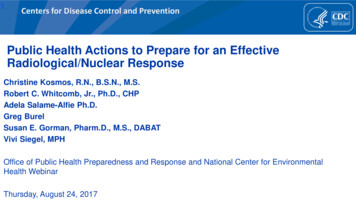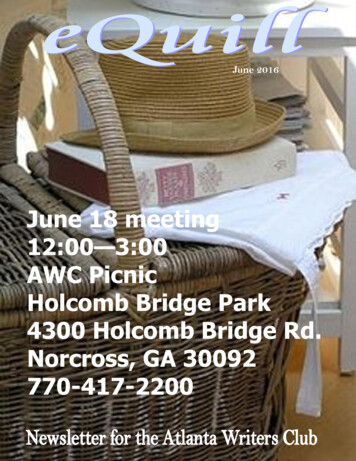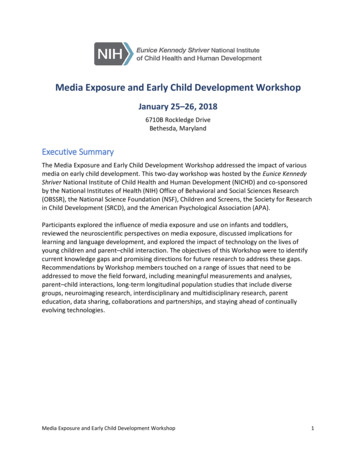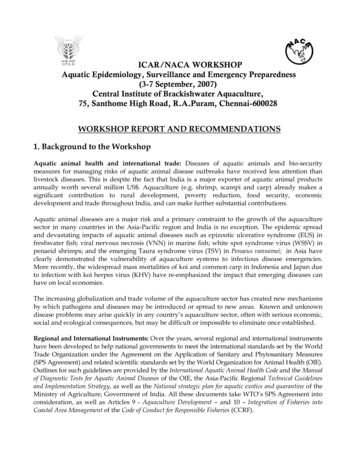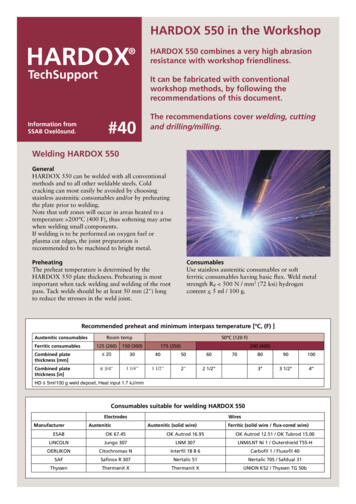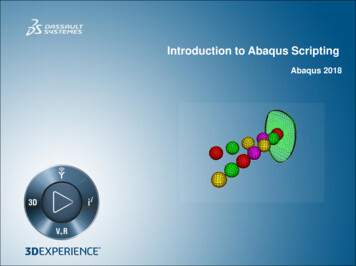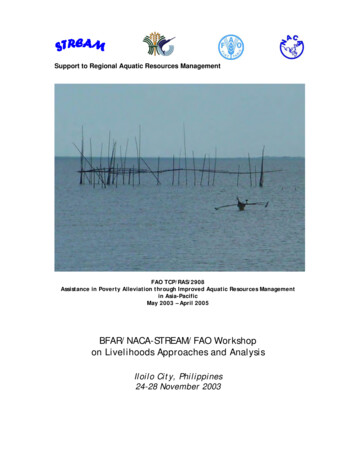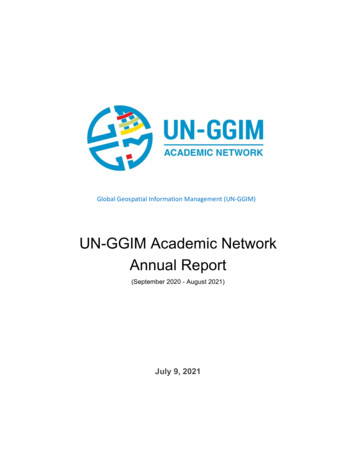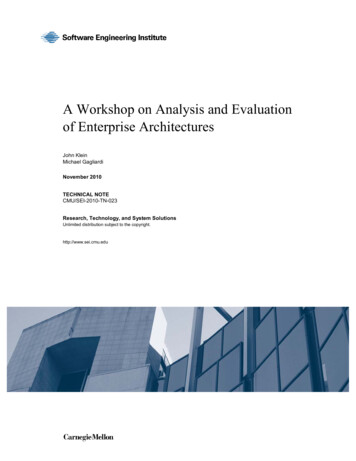
Transcription
A Workshop on Analysis and Evaluationof Enterprise ArchitecturesJohn KleinMichael GagliardiNovember 2010TECHNICAL NOTECMU/SEI-2010-TN-023Research, Technology, and System SolutionsUnlimited distribution subject to the copyright.http://www.sei.cmu.edu
This report was prepared for theSEI Administrative AgentESC/XPK5 Eglin StreetHanscom AFB, MA 01731-2100The ideas and findings in this report should not be construed as an official DoD position. It is published in theinterest of scientific and technical information exchange.This work is sponsored by the U.S. Department of Defense. The Software Engineering Institute is a federallyfunded research and development center sponsored by the U.S. Department of Defense.Copyright 2010 Carnegie Mellon University.NO WARRANTYTHIS CARNEGIE MELLON UNIVERSITY AND SOFTWARE ENGINEERING INSTITUTE MATERIAL ISFURNISHED ON AN “AS-IS” BASIS. CARNEGIE MELLON UNIVERSITY MAKES NO WARRANTIES OFANY KIND, EITHER EXPRESSED OR IMPLIED, AS TO ANY MATTER INCLUDING, BUT NOT LIMITEDTO, WARRANTY OF FITNESS FOR PURPOSE OR MERCHANTABILITY, EXCLUSIVITY, OR RESULTSOBTAINED FROM USE OF THE MATERIAL. CARNEGIE MELLON UNIVERSITY DOES NOT MAKEANY WARRANTY OF ANY KIND WITH RESPECT TO FREEDOM FROM PATENT, TRADEMARK, ORCOPYRIGHT INFRINGEMENT.Use of any trademarks in this report is not intended in any way to infringe on the rights of the trademark holder.Internal use. Permission to reproduce this document and to prepare derivative works from this document forinternal use is granted, provided the copyright and “No Warranty” statements are included with all reproductionsand derivative works.External use. This document may be reproduced in its entirety, without modification, and freely distributed inwritten or electronic form without requesting formal permission. Permission is required for any other externaland/or commercial use. Requests for permission should be directed to the Software Engineering Institute atpermission@sei.cmu.edu.This work was created in the performance of Federal Government Contract Number FA8721-05-C-0003 withCarnegie Mellon University for the operation of the Software Engineering Institute, a federally funded researchand development center. The Government of the United States has a royalty-free government-purpose license touse, duplicate, or disclose the work, in whole or in part and in any manner, and to have or permit others to do so,for government purposes pursuant to the copyright license under the clause at 252.227-7013.For information about SEI publications, please visit the library on the SEI website (www.sei.cmu.edu/library).
Table of ContentsAcknowledgmentsAbstractvvii1A Workshop on Analysis and Evaluation of Enterprise Architectures1.1 Background1.2 Workshop Participants1.3 About This Workshop1.4 Organization of This Report111232Definitions and Boundaries2.1 Defining Enterprise Architecture2.2 Relationship Between Enterprise Architecture and the Enterprise Business2.3 Bounding Enterprise Architecture in Practice44453Enterprise Architecture Design and Documentation Practices3.1 Typical Enterprise Architecture Artifacts3.2 Enterprise Architecture Artifacts – Depth and Detail3.3 Projects Are the Units of Delivery3.4 Decisions Are First-Class Artifacts3.5 Use of Patterns Guides Projects7788994Evaluation of Enterprise Architectures in Practice4.1 Enterprise Architecture Evaluation Criteria4.2 Evaluation Context4.3 The Role of Quality Attributes in Enterprise Architecture Evaluation4.4 Evaluation Methods4.5 Federation and Acquisition1010101112135Summary5.1 Workshop Findings5.2 Future Work141415Appendix A – Survey of Enterprise Architecture Definitions17Appendix B –SEI Enterprise Architecture Analysis and EvaluationEngagement Model19Acronyms and Abbreviations27References29i CMU/SEI-2010-TN-023
List of FiguresFigure 1:Enterprise Architecture Ties the Enterprise's Operating Model to the Foundation forExecution Through an Engagement ModelFigure 2:Architecture Analysis Tradeoff Method (ATAM) Process Flow23Figure 3:SEI Enterprise Architecture Engagement Model24ii CMU/SEI-2010-TN-0235
List of TablesTable 1:Workshop Participants1Table 2:Workshop Agenda2Table 3:Workshop Questions3iii CMU/SEI-2010-TN-023
iv CMU/SEI-2010-TN-023
AcknowledgmentsThe authors of this report gratefully acknowledge the participants of the workshop, whose contributions and energy made it possible.We are also grateful to Ms. Carolyn Kernan of the Software Engineering Institute, who was responsible for the formidable task of handling all of the workshop’s many logistical matters.v CMU/SEI-2010-TN-023
vi CMU/SEI-2010-TN-023
AbstractThis report summarizes a workshop on analysis and evaluation of enterprise architectures that washeld at the Carnegie Mellon Software Engineering Institute (SEI) in April of 2010. The SEI invited accomplished practitioners from government and industry to discuss key issues in analyzingand evaluating enterprise architectures. After several opening talks by individuals who presentedthe state of the practice of enterprise architecture within their own organizations, the group considered a series of questions, including (1) Is there a fundamental difference between analyzing andevaluating enterprise architectures and system of system architectures? (2) How are qualityattribute concerns expressed and analyzed in practice for an enterprise architecture? (3) How areenterprise architectures evaluated in practice? For each question, discussion included consideration of the current state of the practice, identification of difficulties sufficient to motivate an organization to seek a solution or an alternative (“pain points”), challenges in current practice, anddifferences between government and industry contexts. This report summarizes the workshop dialogue and findings, and presents a proposal for an Enterprise Architecture Analysis and Evaluation process.vii CMU/SEI-2010-TN-023
viii CMU/SEI-2010-TN-023
1 A Workshop on Analysis and Evaluation of EnterpriseArchitectures1.1BackgroundThe Architecture-Centric Engineering team at the Carnegie Mellon Software Engineering Institute (SEI) has been extending its research from software architectures into the realms of softwarereliant system architectures and system-of-systems architectures. This work has focused on extending the principles of the SEI Quality Attribute Workshop and the SEI Architecture TradeoffAnalysis Method (ATAM ) to develop methods applicable to larger scale architectures, as reported by Gagliardi and colleagues (Gagliardi 2009).These methods have been successfully applied to development and acquisition in the DoD tacticalsystems domain. In 2009, the Architecture-Centric Engineering team launched an effort to determine whether the approach described by Gagliardi and colleagues could be applied to help organizations systematically analyze and evaluate enterprise architectures (Gagliardi 2009).This workshop was held to help the SEI better understand these issues: the state of the practice inenterprise architecture (EA), the differences in the practice between government and industry contexts, and where analysis and evaluation methods fit into EA practice.1.2Workshop ParticipantsThis workshop assembled a group of experts and practitioners in the field of EA. The participantsare listed (in alphabetical order) in Table 1. The participants were invited based on their expertiseand interest in exploring (1) the challenges of defining the appropriate analysis and evaluation methods for enterprise architectures; (2) the timing of these activities within the architecture development life cycle; and (3) EA evaluation criteria.Table 1:Workshop ParticipantsNameOrganizationDavid CuylerSandia National LaboratoriesMichael GagliardiSEI Architecture Centric Engineering InitiativeLinda Parker GatesSEI Acquisition Support ProgramJohn GrassoFederal Railroad AdministrationCOL Michael GrayU.S. Army CIO/G-6John KleinSEI Architecture Centric Engineering InitiativeIan KomorowskiWhitney, Bradley, & Brown, Inc.Donna MarcumVeterans Health AdministrationPlamen PetrovBlue Cross Blue Shield AssociationTodd TiegerDeloitte & Touche LLPJeff TyreeCapital One Carnegie Mellon is registered in the U.S. Patent and Trademark Office by Carnegie Mellon University. Architecture Tradeoff Analysis Method and ATAM are registered in the U.S. Patent and Trademark Office byCarnegie Mellon University.1 CMU/SEI-2010-TN-023
1.3About This WorkshopTable 2 shows the agenda for the workshop. After a short welcome and overview that establishedthe purpose and expected outcomes of the workshop, several participants delivered short presentations that described the state of EA in their own organizations. The SEI staff gave a short presentation on the SEI System of Systems specification and evaluation techniques. The material presented by the SEI was referred to frequently in the workshop discussions, and so is contained inAppendix B of this report.Table 2:Workshop AgendaDay 120 April 2010TimeTopic0800-0830Continental Breakfast0830-0845Welcome and background; Workshop goals, purpose, and approachJohn Klein, SEI0900-1130Short invited presentations on the practice of enterprise architecture, relevant to the workshopAttendees invited tomake a presentation1130-1200Discussion and formation of working groupsAll1200-1300LUNCH1300-1700Working groups meetDay 221 April 2010TimeTopic0800-0830Continental Breakfast0830-0900Plenary: Discussion; Summary of progress so far;Working groups “course correction” if necessaryAll0900-1100Working groups meetAll1100-1200Working groups prepare for presentationAll1200-1330Working Lunch - Working group presentations and discussion1330-1400Wrap-up and next stepsPresenterAllPresenterAllOn Day 1, the workshop participants elected not to split into two working groups, but to operateas a single working group for the entire workshop. Therefore the preparation of the presentationand delivery of the presentation on Day 2 were essentially a single activity.The single working group addressed a series of questions, listed in Table 3. For each question,there was a discussion of the current state of the practice in this area. Participants then identifieddeficiencies and “pain points” in the current practice, discussed approaches and challenges tochanging current practice, and discussed whether and how the issues differed in government andindustry contexts.2 CMU/SEI-2010-TN-023
Table 3:Workshop QuestionsIs there a difference between the artifacts for an enterprise architecture and a system-of-systems (SoS) or systemarchitecture?How are enterprise architectures analyzed?How does an organization develop evaluation criteria for an enterprise architecture?How and when are enterprise architectures evaluated?What is “in scope” for analyzing and evaluating enterprise architectures?Can an enterprise architecture be viewed as a set of system of systems? If so, can existing SoS analysis and evaluation methods be applied to the enterprise architecture?What role do quality attributes play in analysis and evaluation of enterprise architectures?1.4Organization of This ReportThis document summarizes the discussions from the workshop. The report is laid out as follows: Sections 2 through 4 summarize the discussions of the working group. As the group discussed questions, recurring themes and crosscutting issues emerged, and so this content isorganized thematically, rather than question by question. Section 5 summarizes the findings of the workshop. Section 6 outlines how the SEI System of Systems (SoS) Architecture Engagement canbe applied to enterprise architectures. Appendix A surveys definitions of EA.3 CMU/SEI-2010-TN-023
2 Definitions and BoundariesThis section summarizes discussions about the definition of EA, boundaries of EA, and relationship of EA to the enterprise business.2.1Defining Enterprise ArchitectureParticipants preferred to use the definition of architecture from the Institute of Electrical and Electronic Engineers (IEEE) and substitute system with enterprise to create a working definition ofEA (IEEE 2000). IEEE-1471 Definition of Architecture: “The fundamental organization of a system embodied in its components, their relationships to each other, and to the environment, and theprinciples guiding its design and evolution.” Proposed Definition of Enterprise Architecture: “The fundamental organization of an enterprise embodied in its components, their relationships to each other, and to the environment, and the principles guiding its design and evolution.”EA is different from other architecture disciplines (software, system, and system-of-systems) inthat the enterprise generally exists before any EA activity is started, and must continue to existand function as it is being changed. The evolution perspective included in the IEEE definitionemphasizes that evolution is an essential consideration in EA in practice.Appendix A presents a brief survey of other definitions of EA.2.2Relationship Between Enterprise Architecture and the Enterprise BusinessMany of the participants supported the assertions that “enterprise architecture is a strategic activity.” One participant asserted that this strategic perspective may distinguish EA from SoS and system architectures.EA plays a critical role in supporting and informing the strategic decisions made within the organization; however, participants report that EA activities are typically underfunded. This seems tostem from short-term management focus, difficulty collecting return-on-investment data, and difficulty quantifying the value of any strategic activity.One of the participants showed Figure 1, taken from the book by Ross, Weill, and Robertson(Ross, Weill, & Robertson, 2006).4 CMU/SEI-2010-TN-023
Figure 1: Enterprise Architecture Ties the Enterprise's Operating Model to the Foundation forExecution Through an Engagement Model (Ross, Weill, & Robertson, 2006)One participant proposed three operating modes for enterprise architects within the enterprise:1.At the lowest level, enterprise architects operate in an urgent response mode, reacting tocrises as they arise.2.Next, enterprise architects may operate in a continuous improvement mode, making incremental changes and generally avoiding crises.3.Finally, enterprise architects may operate in a transformative change mode, collaboratingwith business leaders to enable new business capabilities and new business models.In practice, enterprise architects are nearly always operating in all three modes, but the most effective organizations will spend less effort in the urgent response and more in transformativechange.2.3Bounding Enterprise Architecture in PracticeThe Open Group Architecture Framework (TOGAF) defines EA as comprising four domains (TheOpen Group 2009):1.The business architecture defines the business strategy, governance, organization, and keybusiness processes.2.The data architecture describes the structure of an organization’s logical and physical dataassets and data management resources.5 CMU/SEI-2010-TN-023
3.The application architecture provides a blueprint for the individual application systems tobe deployed, their interactions, and their relationships to the core business processes of theorganization.4.The technology architecture describes the logical software and hardware capabilities thatare required to support the deployment of business, data, and application services. This includes IT infrastructure, middleware, networks, communications, processing, standards, andso on.Most participants considered “enterprise architecture” to be typically implemented and practicedas “enterprise information systems/information technology (IS/IT) architecture,” comprising onlythe last three domains. An exception among organizations represented at this workshop was theVeterans Health Administration, which is creating an enterprise business architecture that is “ITagnostic.”The partition between business architecture and the other three domains seems to be driven bylines of authority and control of the business architecture domain. An EA practice is generallyhosted by the Chief Information Officer or some other IS/IT-oriented segment of the enterprise.Organizational relationships and roles between EA-IS/IT and business architecture within an EAvary with the organization’s history, culture, and maturity. Business process modeling is typicallymanaged and performed outside of the EA unit, and may be performed with less precision than isrequired to support enterprise IS/IT architecture. In these cases, enterprise architects may do “justenough” business modeling to support their own needs. An organization that is just starting todocument an EA can recover the business architecture from existing or legacy systems (by reverseengineering the business rules codified in software and then applying expert interpretation).This delineation of EA scope is a more general issue—various organizational structures and linesof authority result in the organization’s adding responsibilities to or removing responsibilitiesfrom the scope of the EA team.One participant asserted that “EA is a management discipline,” and the scope should include activities such as outsourcing and managing the supply chain. In the government context, scopewould be extended to include acquisition-related considerations.For this workshop, participants decided to bound EA to “enterprise information systems/information technology (IS/IT) architecture,” comprising the data, application, and technologydomains. Business architecture provides context and linkage from the IS/IT architecture to theorganization’s business goals.6 CMU/SEI-2010-TN-023
3 Enterprise Architecture Design and DocumentationPracticesThis section summarizes discussions addressing the design life cycle and artifacts, to help answerthe following questions: Where would architecture analysis and evaluation fit into the EA life cycle? What artifacts would be available to support analysis and evaluation?3.1Typical Enterprise Architecture ArtifactsA roadmap is a plan that defines a sequence of architecture states or transition architectures thatwill change the “as-is” EA to a desired target architecture. Participants agreed that this roadmap isthe critical EA artifact that relates technology to business goals, and ties together the many concurrent projects underway in an organization at any time. A typical roadmap in industrial practicecovers three years—it is felt that projecting beyond that time frame is not efficient.Other artifacts typically developed and maintained included reference models strategic plans (for DoD enterprise architectures, would include campaign plans andposture statements) architecture principles conceptual architectures and other architecture descriptions, describing baseline, targetand transition architectures architecture patternsIn general, these artifacts are a mixture of different types of products (the DoDAF, TOGAF, system architecture, spreadsheets, Visio diagrams, and other tools) and reside in different repositories. For the U.S. Army, the Capability Architecture Development and Integration Environment(CADIE) is the primary repository for EA artifacts (products); however, other information relevant to the EA resides in other repositories. Federation of data from multiple repositories is necessary for making meaningful decisions using the EA.Given that the participants stressed that the primary role of EA is to support enterprise decisionmaking (refer to Section 2.2 above), artifacts need to be selected, developed, and maintained withthis role in mind.During this discussion, it became clear that the terminology used in the DoD, other governmentagencies, and commercial practice are very different and impact the ability to apply principlesacross domains. Consistency, or at least a comprehensive mapping, would be a great help to practitioners.7 CMU/SEI-2010-TN-023
3.2Enterprise Architecture Artifacts – Depth and DetailAll participants agreed that it is easy to get bogged down in EA documentation. Available toolscan probe the data network and crawl through the existing systems to extract partial representations of the as-is architecture. It’s easy to add more detail to these repositories manually, leadingto bloated architecture documentation that is expensive and time consuming to maintain and sooften becomes stale. It was noted that each additional level of decomposition adds twice the effortneeded to complete the previous level. EA documentation carried down to the level of a technicalarchitecture is too detailed to be useful or effective. The appropriate level of documentationcomes back to the use of EA to support strategic decision making within the organization—thedocumentation detail needs to be “just enough” to support the decisions that the organization mustmake.Development tooling is necessary in any case—tools in use ranged from iServer (Visio backed bya database repository) (Orbus Software 2010) for a small enterprise, up to more sophisticatedtools such as ARIS (IDS Scheer 2010), Casewise (Casewise 2010), IBM System Architect (IBM2010), and Troux (Troux Technologies 2010). Even the more sophisticated tools like Troux didnot readily support documenting tradeoffs between design alternatives. We will discuss why documenting such tradeoffs is important in Section 6.A critical activity in successful EA teams is communication about the EA with the rest of the enterprise. Several participants noted that the representations produced by the tools (e.g., variousUnified Modeling Language [UML]) diagrams and entity-relationship diagrams) are not useful forcommunication outside of the architecture team. One participant talked about keeping the toolrepository “in his back pocket” to be used by the EA team for decision making but never shown tostakeholders. Alternative representations—that are more “executive-friendly”—are needed forcommunication with stakeholders.Several participants pointed out that the practice of keeping the EA models up to date with thesolution/project architectures and as-built infrastructure varies among organizations. Up-to-datemodels help new stakeholders, but most decision makers seem to quickly internalize any conformance discrepancies. Within an organization, some models are kept current while others are allowed to lag. In fact, workshop participants who had invested heavily in using these tools to develop the initial capture of the EA expressed the sentiment that while they felt this work wascrucial to their efforts, ongoing maintenance of the models was not cost effective. There wasagreement that documentation of the invariants and principles should be kept current.3.3Projects Are the Units of DeliveryThe EA roadmap is realized by a number of projects, each producing a project or solution architecture. These projects vary widely in scope and complexity, ranging from simple (for example, anew version of a vendor platform or package), to complex (for example, moving to a new vendorplatform or adding a new application). Complexity should not be confused with architecture significance—some “simple” projects are architecturally significant, while some “complex” projectsmay have little or no architectural impact. The distinction is not always explicit—having a decision model to systematically distinguish between the two types of projects based on architecturesignificance would be useful.8 CMU/SEI-2010-TN-023
A project may also be categorized according to the operating mode that drives it (see Section 2.2above). Projects may include both re-engineering of existing components and packages, and development of new components and packages.3.4Decisions Are First-Class ArtifactsThe participants favored defining EA in terms of structures determined by components and relationships. However, in considering how to document an EA, there was agreement that documenting decisions as first-class artifacts is more important than documenting structure.The process of making, evaluating, documenting, and managing the version/configuration of decisions is at the heart of the EA governance process.One of the participants presented the metamodel that his organization uses for documenting EA,which includes decisions and rationale as explicit elements in the metamodel.3.5Use of Patterns Guides ProjectsOne important type of EA decision is the selection of “patterns.” Projects are frequently specifiedin terms of the selected patterns.In practice, participants’ use of the term patterns was an extension of the typical definition of architecture patterns. A pattern was defined as a reference to an already instantiated set of architecture elements and relationships in their enterprise—an exemplar of how to address a particularbundle of architecture concerns. The pattern also includes technology and platform decisions. Often, little additional analysis or evaluation is performed, since the quality characteristics of theexemplar are already established through its existence in a working implementation.9 CMU/SEI-2010-TN-023
4 Evaluation of Enterprise Architectures in PracticeThis section discusses how enterprise architectures are evaluated in practice.4.1Enterprise Architecture Evaluation CriteriaThe scope of an EA evaluation should include the baseline (“as-is”) architecture, the target (“tobe”) architecture, and the EA roadmap. The evaluation is focused on evolution from baseline totarget architectures.In current practice, the key evaluation criterion is line-of-sight1 from roadmap projects and thedecisions within the enterprise and solution architectures to the enterprise business goals or capability requirements. The business architecture provides context for the rest of the EA and so canprovide this linkage from business goals to architecture.4.2Evaluation ContextEvaluation occurs at multiple levels: entire enterprise, division or line-of-business, and project.Higher levels are more focused on alignment than technical issues, while lower levels focus ontechnical concerns.Evaluations should consider the current (as-is) state, including known open issues, gaps in functionality or qualityattributes, and inconsistencies (in solution patterns, for example) proposed changes that may impact the architecture, including new capabilities, infrastructure changes, and operational changes target (to-be) architecture, including roadmap and tradeoff analysis of architecture optionsCurrent evaluation practice gives little consideration to the target architecture. It may happen thatthe EA is too large to effectively create a target architecture; in such cases snapshots of sections ofthe architecture may suffice. Several participants cited examples of target architectures for largeenterprises, so size is not a hard limiting factor. Like the target architectures, the as-is architecturemay also be incomplete, which hinders effective evaluation.In discussions of current EA evaluation practices, there was a clear difference between government and industry contexts. Government scale is often larger, and government organizations seemto have better discipline around practices such as business process management. On the industryside, time-to-market pressures often drive decisions. Budget constraints play a large role in bothcontexts, affecting EA development and evaluation.In the government context, the Clinger-Cohen Act and associated regulations provide minimumstandards for EA evaluation. In particular 1The Government Accountability Office (GAO) audits the practices used to create the EA.Participants used the terms line-of-sight and alignment interchangeably.10 CMU/SEI-2010-TN-023
The Office of Management and Budget (OMB) audits how the organization is using theEA to meet business performance goals.The SEI principles of evaluating an architecture to determine how well the architecture supportsbusiness goals seems to complement the OMB standard.In both commercial and government contexts, an organization generally uses the same governanceprocess for all projects, with no tailoring to account for variation in project scope or complexity.For example, changes to existing capabilities use the same process as introduction of new capabilities.One particular evaluation context is what one participant termed “disruptive requirements.” Theseare business requirements that have broad architectural significance and may necessitate changesin common infrastructure. Such requirements should be escalated, reviewed, and carefully evaluated.4.3The Role of Quality Attributes in Enterprise Architecture EvaluationThe participants had varying levels of familiarity with the SEI quality attribute-based approach toarchitecture. Among participants with more familiarity there was consensus that current EA practices have insufficient focus on quality attributes, and there is a need to elevate quality attributeconcerns and tradeoffs to first-class status in EA development and evaluation.There are some standards that identify EA quality attributes. For example, Control Objectives forInformation and related Technology (COBIT) identifies effectiveness efficiency confidentiality integrity reliability availability complianceOther typical EA quality attributes would include profitability affordability scalability manageability alignment integration/interoperability sustainability agility11 CMU/SEI-2010-TN-023
Presentations of EA artifacts by several participants showed that quality attributes are sometimesalluded to in EA documentation, in project descriptions, or in roadmap annotations, but a needexists to make quality attribute concerns more explicit.Participants discussed the use of end-to-end business threads to systematically address qualityattribute concerns. One participant suggested that end-to-end threads could be used to identify andresolve contradictory architecture decisions. These threads might be constructed by chaining together existi
4.1 Enterprise Architecture Evaluation Criteria 10 4.2 Evaluation Context 10 4.3 The Role of Quality Attributes in Enterprise Architecture Evaluation 11 4.4 Evaluation Methods 12 4.5 Federation and Acquisition 13 5 Summary 14 5.1 Workshop Findings 14 5.2 Future Work 15 Appendix A - Survey of Enterprise Architecture Definitions 17 Appendix B .


